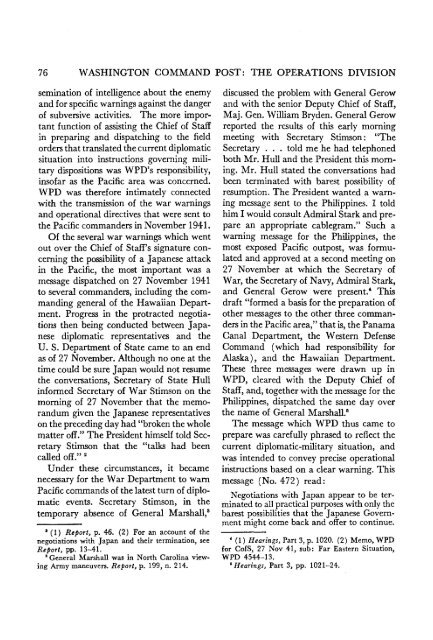To download as PDF click here - US Army Center Of Military History
To download as PDF click here - US Army Center Of Military History
To download as PDF click here - US Army Center Of Military History
You also want an ePaper? Increase the reach of your titles
YUMPU automatically turns print PDFs into web optimized ePapers that Google loves.
76 WASHINGTON COMMAND POST: THE OPERATIONS DIVISION<br />
semination of intelligence about the enemy<br />
and for specific warnings against the danger<br />
of subversive activities. The more important<br />
function of <strong>as</strong>sisting the Chief of Staff<br />
in preparing and dispatching to the field<br />
orders that translated the current diplomatic<br />
situation into instructions governing military<br />
dispositions w<strong>as</strong> WPD's responsibility,<br />
insofar <strong>as</strong> the Pacific area w<strong>as</strong> concerned.<br />
WPD w<strong>as</strong> t<strong>here</strong>fore intimately connected<br />
with the transmission of the war warnings<br />
and operational directives that were sent to<br />
the Pacific commanders in November 1941.<br />
<strong>Of</strong> the several war warnings which went<br />
out over the Chief of Staff's signature concerning<br />
the possibility of a Japanese attack<br />
in the Pacific, the most important w<strong>as</strong> a<br />
message dispatched on 27 November 1941<br />
to several commanders, including the commanding<br />
general of the Hawaiian Department.<br />
Progress in the protracted negotiations<br />
then being conducted between Japanese<br />
diplomatic representatives and the<br />
U. S. Department of State came to an end<br />
<strong>as</strong> of 27 November. Although no one at the<br />
time could be sure Japan would not resume<br />
the conversations, Secretary of State Hull<br />
informed Secretary of War Stimson on the<br />
morning of 27 November that the memorandum<br />
given the Japanese representatives<br />
on the preceding day had "broken the whole<br />
matter off." The President himself told Secretary<br />
Stimson that the "talks had been<br />
called off." 2<br />
Under these circumstances, it became<br />
necessary for the War Department to warn<br />
Pacific commands of the latest turn of diplomatic<br />
events. Secretary Stimson, in the<br />
temporary absence of General Marshall, 3<br />
2<br />
(1) Report, p. 46. (2) For an account of the<br />
negotiations with Japan and their termination, see<br />
Report, pp. 13-41.<br />
3 General Marshall w<strong>as</strong> in North Carolina viewing<br />
<strong>Army</strong> maneuvers. Report, p. 199, n. 214.<br />
discussed the problem with General Gerow<br />
and with the senior Deputy Chief of Staff,<br />
Maj. Gen. William Bryden. General Gerow<br />
reported the results of this early morning<br />
meeting with Secretary Stimson: "The<br />
Secretary . . . told me he had telephoned<br />
both Mr. Hull and the President this morning.<br />
Mr. Hull stated the conversations had<br />
been terminated with barest possibility of<br />
resumption. The President wanted a warning<br />
message sent to the Philippines. I told<br />
him I would consult Admiral Stark and prepare<br />
an appropriate cablegram." Such a<br />
warning message for the Philippines, the<br />
most exposed Pacific outpost, w<strong>as</strong> formulated<br />
and approved at a second meeting on<br />
27 November at which the Secretary of<br />
War, the Secretary of Navy, Admiral Stark,<br />
and General Gerow were present. 4 This<br />
draft "formed a b<strong>as</strong>is for the preparation of<br />
other messages to the other three commanders<br />
in the Pacific area," that is, the Panama<br />
Canal Department, the Western Defense<br />
Command (which had responsibility for<br />
Al<strong>as</strong>ka), and the Hawaiian Department.<br />
These three messages were drawn up in<br />
WPD, cleared with the Deputy Chief of<br />
Staff, and, together with the message for the<br />
Philippines, dispatched the same day over<br />
the name of General Marshall. 5<br />
The message which WPD thus came to<br />
prepare w<strong>as</strong> carefully phr<strong>as</strong>ed to reflect the<br />
current diplomatic-military situation, and<br />
w<strong>as</strong> intended to convey precise operational<br />
instructions b<strong>as</strong>ed on a clear warning. This<br />
message (No. 472) read:<br />
Negotiations with Japan appear to be terminated<br />
to all practical purposes with only the<br />
barest possibilities that the Japanese Government<br />
might come back and offer to continue.<br />
4<br />
(1) Hearings, Part 3, p. 1020. (2) Memo, WPD<br />
for CofS, 27 Nov 41, sub: Far E<strong>as</strong>tern Situation,<br />
WPD 4544-13.<br />
5<br />
Hearings, Part 3, pp. 1021-24.
















